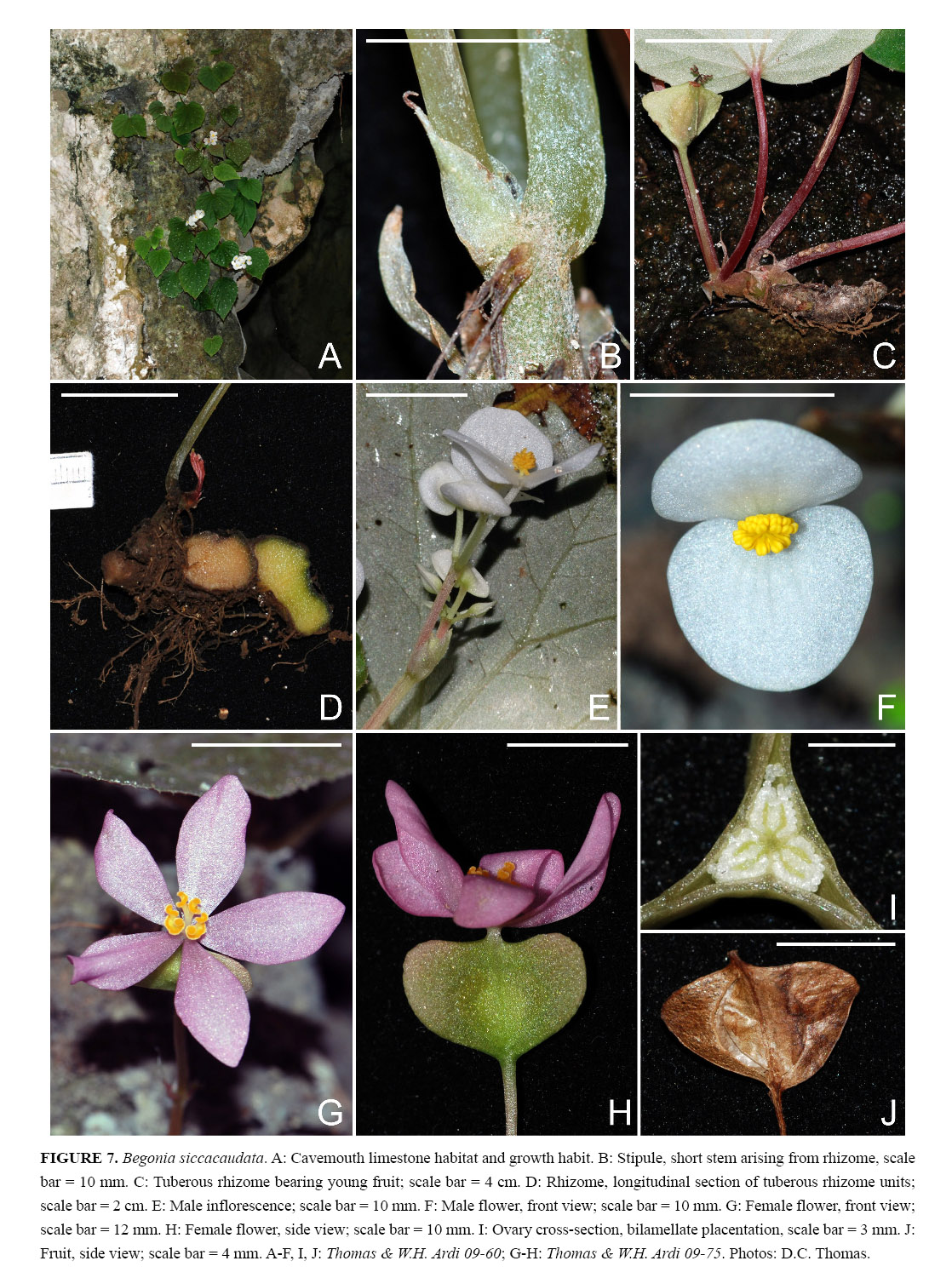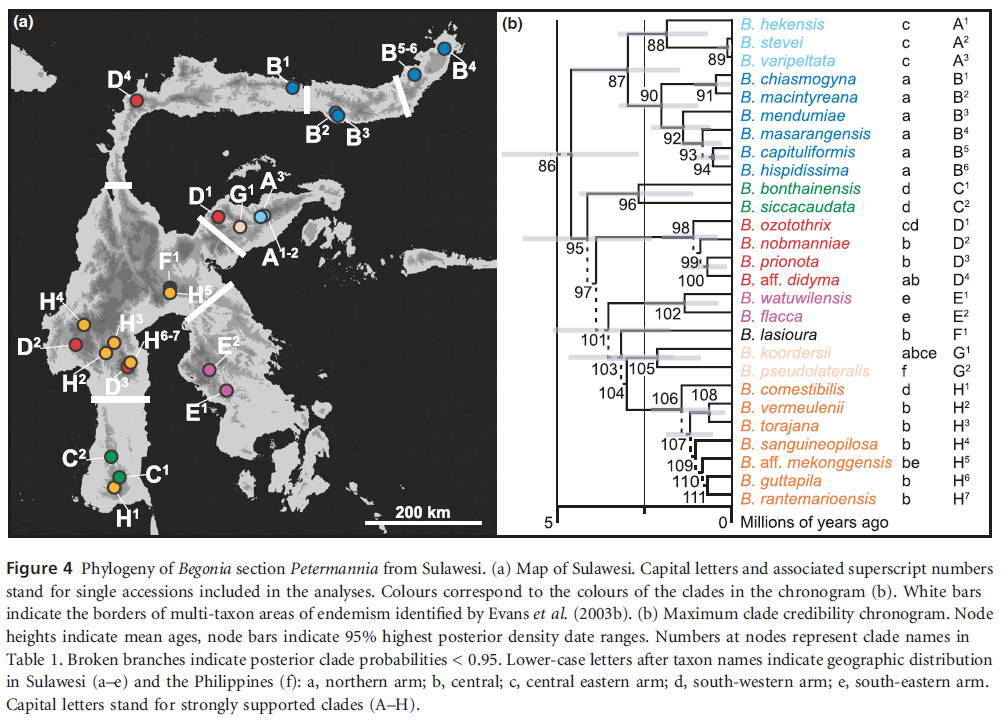Begonia siccacaudata, nom. val., in Blumea 45(2): 400. 2000
Primary tabs

Diagnosis
- Herba parva, acaulis, rhizomate brevi crasso, species unica in sectione habitu talli. Inflorescentia mascula terminalis, thyrsoidea, folia vulgo, absentia, stipulae praesentes et persistentes, pedunculos monochasia umbelliformes gerens, axibus lateralibus reductis, bracteis absentibus, Flos femineus solitarius in axis foliolorum rhizomati insidens. - Typus: Indonesia, Sulawesi Selatan, c. 12 km ESE of Maros near Bantimurung Waterfalls, 05°02'S, 119°41'E, 60 m a.s.l., J.J. Wieringa 1902 (holo WAG). (Doorenbos, J. 2000: Begonia siccacaudata (Begoniaceae): A new species from Sulawesi. – Blumea 45: 399-402)
Description
- Stemless monoecious perennial herb. Rhizome tuberous, branched, branches up to 3 cm long and 1.1. cm thick, green at first, later light greyish brown, smooth but for a few remnants of stipules and petioles.
Leaves glabrous. Stipules narrowly triangular or slightly ovate, rapidly shrivelling but not caducous, up to 5 mm long and 2-3 mm broad at base, acute with a hair up to 2 mm long implanted adaxially just under the tip. Petioles up to 5 cm long, up to 2 mm thick when fresh, much thinner when dried. Leaf blade broadly ovate, usually asymmetrical, slightly fleshy when fresh but very thin and brittle when dried, upper side dark greyish green with rows of white spots along the edge and between the nerves, dark or light red beneath, up to 5-6 by 5 cm, slightly cordate, acute, edge entire or serrulate, fimbriate with minute hairs up to 1 mm long.
Male inflorescence a glabrous thyrse. Main axis more or less geniculate, internodes up to 35 mm long, at each internode 2 stipules, like those on the rhizome but without or with only a minute hairs, leaves nearly always absent, occasionally rudimentary, peduncles in the axils of the (absent) leaves, up to 45 mm long, bearing cymes terminated by a pedicelled male flower flanked by two monochasia with almost completely reduced axes.
Male flowers on pedicels 20-28 mm long, tepals 2 elliptic or oval, obtuse, 9-10 by 11-12 mm, entire, bright rose-pink. Androecium actinomorphic, stamina 20-40, filaments unequal, the longest ones in the centre, 0.5-1.5 by the length of the anthers, connective not visible between the pollen sacs and not produced. Pedicel, tepals and androecium are shed as a whole, the peduncle dries out but remains on the plant; eventually the main axis of the inflorescence including the stipules also dries out and persists on the plant, at least for some time (hence the specific epithet).
Female inflorescences solitary on the rhizome, glabrous, peduncle (if present, it is covered by stipules and extremely short apparently bearing one flower, pedicel initially short but elongating to up to 45 mm in the ripe fruit, 1 mm thick when fresh; bracteoles absent; tepals 5, 11-13 by 7-9 mm, oblong to lanceolate, entire, pale pink-rose. Styles 3, shortly united at base, bifid at half of their length, the branches untied br a stigmatic band that spirals once around them. Ovary with 3 locules, placentae axillary, bilamellate with ovules on both surfaces.
Fruit erect, glabrous, 8-10 mm long, greatest distance, between the distal ends of the wings 11-22 mm, tepals and styles +- caducous, wings 3, subsequal, triangular, widest at or near the top. Dehiscence of fruit not yet known. (Doorenbos, J. 2000: Begonia siccacaudata (Begoniaceae): A new species from Sulawesi. – Blumea 45: 399-402)
Habitat
- Forest, lithophytically on karst limestone, often on rock and carve entrances, between 50 and 1000 m a.s.l.
Distribution
Asia-Tropical: Sulawesi (Sulawesi endemic)
Endemic to Indonesia, Sulawesi, South Sulawesi Selatan.
See specimen tab for map of point distribution data of georeferenced specimens.
See specimen tab for map of point distribution data of georeferenced specimens.
Etymology
- The specific epithet refers to the dried persistent inflorescence axes: "[...] eventually the main axis of the inflorescence including the stipules also dries out and persists on the plant, at least for some time (hence the specific epithet)" (Doorenbos, 200).
Molecular Systematics
- GenBank
- see Thomas et al., 2011 (Thomas, D.C., Hughes, M., Phutthai, T., Rajbhandary, S., Rubite, R., Ardi, W.H. & Richardson, J.E. 2011: A non-coding plastid DNA phylogeny of Asian Begonia(Begoniaceae): Evidence for morphological homoplasy and sectional polyphyly. – Molecular Phylogenetics and Evolution 60: 428-444)
- see Thomas et al., 2012 (Thomas, D.C., Hughes, M., Phutthai, T., Ardi, W.H., Rajbhandary, S., Rubite, R., Twyford, A.D. & Richardson, J.E. 2012: West to east dispersal and subsequent rapid diversification of the mega-diverse genus Begonia (Begoniaceae) in the Malesian archipelago. – Journal of Biogeography 39: 98-113)
 |
Specimens
- INDONESIA. Sulawesi, South Sulawesi: Maros, 17 Feb. 1925, Smith 006 (K); Bantimurung, near Makassar, 20 May 1929, A. Rant 48 (BO); Celebes zuid, Bantimoeroeng and vicinity, 20 Feb.1938, P. Buwalda 3702, 3759 (BO); Bantimurung Waterfalls, 20 June 1929, A. Rant 48 (L); Maros, Bantimurung Park, 20 Feb. 1938, P.J. Eyma 3702 (BO, L); Maros, Bantimurung Park, 20 Feb. 1938, P.J. Eyma 3759 (BO, L); Maros, Bantimurung Park, 13 Apr. 1975, W. Meijer 9125 (L); Maros, Bantimurung Park, 12 Feb. 1977, E. Widjaja130 (BO); Karaenta Nature Reserve, 16 Feb. 1981, H. Johansson et al. 8 (L); Karaenta Nature Reserve, 17 Feb. 1981,H. Johansson et al. 24 (L); Maros, about 3 km north Leangleang, at Gunung Kamaseh, 14 June 1986, S.C. Chin 3538(L); Bantimoeroeng, 3 Feb. 1998, W.S. Hoover & H. Wiriadinata 881 (BO); Bantimurung Waterfalls, Nov. 1998, J.van Veldhuizen s.n. (WAG); Bantimurung National Park, Leang-Leang cave, 10 Apr. 2009, D.C. Thomas & W.H. Ardi 09-60 (BO, E); Bantimurung National Park, close to Bantimurung waterfall, 15 Apr. 2009, D.C. Thomas & W.H. Ardi 09-75 (BO, E); Maros District, Bantimurung subdistrict, Patunuang Asue Village, along Biseang Labboro bridge, 22 June 2010, E.A. Widjaya, EAW 9013 (BO); Biringkassi Village, Pangkep, 2 Nov. 2018, W.H. Ardi 321 (BO, KRB, SING); Tanete Riaja, Barru, 12 Nov. 2018, W.H. Ardi 359 (BO, KRB, SING). (Thomas, D.C. & Ardi, W.H. 2020: Synopsis of Begonia (Begoniaceae) of southwest Sulawesi and the Selayar Islands, Indonesia, including one new species. – Phytotaxa 437(2): 73-96. https://doi.org/10.11646/phytotaxa.437.2.4)


